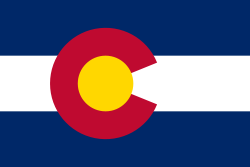Colorado Rapids
| Full name | Colorado Rapids | ||
|---|---|---|---|
| Founded | 1996 | ||
| Stadium | Dick's Sporting Goods Park Commerce City, Colorado (Capacity: 19,680) |
||
| Owner | |||
| Head Coach | |||
| League | Major League Soccer | ||
| 2009 | Western Conference: 6th Overall: 9th Playoffs: DNQ |
||
|
|||
The Colorado Rapids are a professional American soccer club based in the Denver suburb of that participates in Major League Soccer. The club was founded in 1995. The team colors are burgundy, sky blue, and gray. They played their home matches at Mile High Stadium from 1996–2001 and moved into Invesco Field at Mile High in 2002. They moved to Dick's Sporting Goods Park for the 2007 season. The Rapids have made two cup finals in their history, the 1997 MLS Cup and the 1999 U.S. Open Cup, losing both times.
Contents |
History
The First Decade (1996-2006)
The Colorado Rapids were one of the ten founding clubs of Major League Soccer, owned and operated by the Anschutz Corporation (later AEG). The inaugural 1996 season was a forgettable one for Colorado. Despite fielding experienced players like Shaun Bartlett, Chris Henderson, Chris Woods, Roy Wegerle and Marcelo Balboa, and English Head Coach Bobby Houghton, the team finished dead last in the Western Conference with the worst record in the league. Balboa went down in history as the first player ever to score for the club and also the first ever player to record a goal at their home of Mile High Stadium in their first home match in 1996.
The complexion of the team changed dramatically for the following season with new head coach Glenn Myernick and a new General Manager, Dan Counce. Myernick and Counce brought new faces to the squad including Paul Bravo, Wolde Harris, Ross Paule, and keeper Marcus Hahnemann. The team struggled early on, but rallied to grab a postseason spot. The Rapids pulled off two major upsets and advanced to the 1997 MLS Cup final. Chris Henderson scored a mid-air volley past Dallas keeper Mark Dodd in the 87th minute in the Western Conference final, ensuring Colorado's place in the MLS Cup final. They scored in the Cup thanks to a goal by Adrian Paz but lost the final 2-1 to D.C. United.
Colorado continued on a roller coaster of success and disappointment: Myernick brought in more new players including Anders Limpar and Marcus Hahnemann and the club made it to the 1999 US Open Cup final, only to be upset 2–0 by the Rochester Raging Rhinos.
The 2000 season boasted two of the more memorable moments in Rapids history. The first was Marcelo Balboa's famous bicycle kick which garnered the Goal of the Year. The second was clenching a playoff spot in the final game of the season against the Los Angeles Galaxy, with Paul Bravo scoring in the 97th minute.
In 2001 Tim Hankinson took the reins as Colorado's new head coach. Scottish striker John Spencer also joined the club that year. While Hankinson did bring effective players like Mark Chung, Chris Henderson, Carlos Valderrama, and Joe Cannon to the squad—and made the playoffs every year—Hankinson also signed a number of expensive and unsuccessful players including ZiZi Roberts and Darryl Powell. During his coaching stint, the club also traded away club legend Marcelo Balboa, whose career was nearing its end....he played 1 game with New York before retiring.
2002 was a banner year for the Rapids, and they started off their new year at their new home of Invesco Field at Mile High by acquiring two powerhouses and future stars for the team, Pablo Mastroeni and Kyle Beckerman from the defunct Miami Fusion F.C. Chris Henderson went down in history as the first player ever to score a goal in the brand-new stadium. Mark Chung posted record numbers on the season, and Mastroeni shone for the US Men's National Team in that year's World Cup. The club advanced to the MLS Cup Playoffs Semifinals, and although they didn't advance to the MLS Cup, the Rapids did clean up at the MLS postseason awards ceremonies. General Manager Dan Counce was named MLS Executive of the Year and 4 other Rapids front office staff were named as the best at their positions in MLS that year. Mark Chung was named to the League Best XI squad and also took home the MLS Fair Play Award. Finally, the Rapids ticket sales staff was named best in the league after the Rapids led MLS in average home attendance for the first time ever with an average home crowd of over 20,000 fans per home game.
2003 saw the club change their identity, with a rebranding that brought in the new team identity and color scheme of black and blue. Mark Chung and forward John Spencer had banner years. Spencer, the Rapids' team captain, set a new team record by scoring in six consecutive games and tied his own team record with 14 goals on the season. He finished the season third in MLS with 33 points, was a finalist for Honda MVP and was named to the MLS Pepsi Best XI. Joining him on the Best XI was Chung, who tied his career high of a year prior with 11 goals and was second on the team with 28 points. This was Chung’s second consecutive appearance on the MLS Best XI and it marked the first time in league history that two Rapids had been so honored in the same season.
The Rapids set a new MLS record for the lowest home Goals Against Average over an entire season with at 0.53 by only allowing eight goals in 15 matches at Invesco Field during the season, and never more than one in a single game. After Kansas City broke the Rapids’ MLS record 16 game home undefeated streak on June 9, the Black & Blue reeled off 11 more undefeated home games. On the year Colorado was undefeated when scoring more than one goal, a credit to the play of goalkeeper Joe Cannon and the suffocating defense.
Kroenke Sports Enterprises purchased the club in late 2004 and made several changes before the 2005 season. In the front office, KSE replaced long-time executive GM Dan Counce with Charlie Wright, who appointed Fernando Clavijo as the new head coach.
Clavijo and Wright brought in many new additions to the squad including Jeff Cunningham, Terry Cooke, and David "Dedi" Ben Dayan. The team saw steady improvement over the course of the 2005 season. The season's success was highlighted by a dramatic playoff victory over FC Dallas in a penalty shootout, and their claiming of the brand new Rocky Mountain Cup in the tournament's inaugural year.
Colorado's 2006 season seemed to parallel trends from previous years. Clavijo's squad performed inconsistently and only secured a playoff spot at the very last instant. Lightning managed to strike twice as they duplicated their 2005 playoff run by again beating FC Dallas in penalties only to crash out of the Western Conference Final by a two goal deficit. Other highlights from the final black and blue season include securing the Rocky Mountain Cup for the second consecutive year and winning the MLS Reserve Division.
The Modern Era (2007-present)
New head executive Jeff Plush had taken over the business responsibilities of the club when he was named Managing Director in January 2006. One of his main initiatives was to re-invent the club with new colors that meshed with the DNA of other KSE clubs, in the form of burgundy and blue, leading the way towards constructing the world's largest and most state of the art professional soccer stadium and fields complex, Dick's Sporting Goods Park, formulating club-to-club relationships with Arsenal F.C. of the English Premier League and C.F. Pachuca of Mexico, and ushering in a new era of optimism.
The Rapids business-wise enjoyed a fantastic inaugural year at Dick's Sporting Goods Park, hosting numerous international exhibitions, tournaments on the stadium's 24-field complex, and the 2007 MLS All-Star Game; on the pitch though the team's performance was less than ideal.
The team started out strong with a series of good results, including a fantastic 2-1 victory over DC United in frigid conditions on MLS First Kick and the first-ever event in the newest soccer stadium in America. Herculez Gomez went down in history as the first-ever player to score in the Rapids' brand new shining jewel of a stadium. However as the season progressed, the team endured a long winless streak that saw them sink in the standings. Colorado struggled with inconsistent results at the end of the season and ultimately finished just shy of a playoff spot. The major low points in the season included an embarrassing 5-0 loss to the Seattle Sounders in the Lamar Hunt US Open Cup, and a crushing defeat to Real Salt Lake that saw them lose both a playoff berth and the possession of the Rocky Mountain Cup for the first time ever in the last game of the regular season. One of the club's few consolations of the season on the pitch was winning the MLS Reserve Division Championship for the second consecutive year.
Despite underachieving on the field the previous year and protests from the fans, the Rapids elected to honor Fernando Clavijo's contract, which runs though the 2008 season.
Heading into 2008, Rapids GM Charlie Wright and the front office staff bolstered the roster by adding depth to the midfield and defense. Major signings included Christian Gómez and Jose Burciaga Jr. The 2008 season to date has seen a resurgent Rapids side, which started off the season with a complete thrashing of David Beckham and the LA Galaxy by a 4-0 score on Opening Day to launch the season.
The 2009 campaign features head coach Gary Smith in his first full season [1]. Smith took over the reigns from Fernando Clavijo as interim manager after Clavijo resigned for personal reasons. Smiths first appointment was Steve Guppy ex England International as his assistant, Guppy had spent the previous successful season at USL1 team Rochester Rhinos as their Player Assistant Coach. Shortly after, Rapids veteran midfielder Pablo Mastroeni re-signed with the club for four years after mulling potential offers from Europe [2]. The Rapids also signed new four-year contracts with midfielders Colin Clark and Nick LaBrocca and defenders Jordan Harvey and Kosuke Kimura [3]. The Colorado Rapids did acquire former QPR and Chicago Fire goalkeeper Matt Pickens to replace fan-favorite Senegalese goalkeeper Bouna Coundoul. The other major roster move included the arrival of Ivan Guerrero from DC United in exchange for midfielder Christian Gomez and backup goalkeeper Mike Graczyk [4]. The media has criticized the Rapids for not making more roster moves to improve the team for the 2009 season. However, the core of the team remains intact [5].
Image

The Rapids' image has evolved a great deal since their inaugural year. The team has undergone two complete re-brandings.
Originally using green as the primary kit color, the team changed to black and blue for the 2003 season.
As Colorado were preparing to move into Dick's Sporting Goods Park for the 2007 season, the club re-invented themselves again to more closely align with the DNA and color scheme of other KSE teams, changing their colors to burgundy and blue, and creating a brand new shield logo to fit in with more traditional global soccer marks.
Logo
Colorado has had three logos in their history. They originally first used the "river" logo as their primary crest with the "circular" logo as a secondary one. In 2002, the two logos would switch, with the "circular" one becoming the primary.
For the 2007 re-branding, the Rapids created the new shield-style logo, which is the one that is currently used today.
 Colorado Rapids logo (1995-2001) |
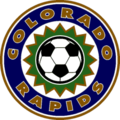 Colorado Rapids logo (2001-2006) |
Colorado Rapids logo (2007-Present) |
Kit
The original look of the Rapids sported a predominantly white kit with green trim, when the club's kit supplier was Puma. Other minor colors such as gold and blue were occasionally incorporated, with the club's association with Reebok.
Eventually black became more heavily used and eventually overtook white as the more dominant color that accompanied the green, when the club switched to Kappa.
The Rapids underwent a more dramatic image change prior to the 2003 season. Following the club's switch to Atletica, the kit colors switched to black and blue vertical stripes, similar to the uniforms worn by Italian Serie A club Internazionale. The blue and black vertical stripes remained almost unchanged when MLS adopted Adidas as their league wide kit sponsor.
The kits underwent one last dramatic change for the 2007 season. The Rapids now sport burgundy and sky blue as their primary colors. The Colorado Rapids also have a brand new third kit, consisting of a white shirt, white socks and burgundy shorts.
The Rapids are one of four MLS clubs (not counting expansion clubs for the 2010 season) not to have sponsorships on the front of their jerseys.
The Rocky Mountain Cup
With Major League Soccer's expansion in 2005, Real Salt Lake became the second team in the Rocky Mountain region and the Rapids' closest neighbor. The supporters of the two clubs created a regular-season competition between the two sides to foster and memorialize this budding rivalry. Colorado won the Rocky Mountain Cup in the first two years, 9 points to 3 and 7 points to 4. In the following year, 2007, Real Salt Lake took the cup. Colorado looked set to take the cup back and advance to the playoffs on the last day of the season when they led RSL in the last minute. However, RSL equalized in the 90th minute, meaning RSL took the Rocky Mountain Cup, and advanced to the 2008 MLS Cup Playoffs at the expense of the Rapids. The winning team's fans maintain control of the actual Cup trophy for the next year, until the next year's winner is determined.
Supporters
While the Rapids have always have been among the top teams in the league in average fan attendance, including leading the league in average fans per game in 2002[1], the club has had a fairly rocky history when it comes to supporters groups or ultras. A handful of formally organized groups have come and gone. While there have been several groups both large and small, the most notable of these were the Jolly Green Men, the River Ratz, and Ultra Azul. Reasons for the failures of these groups include lack of growth, leadership from within the supporters clubs, and tensions between them and Invesco Field stadium security. After the River Ratz become defunct, there was a period of several years where there was no real supporters group.
In 2005 and 2006, two organized supporters groups emerged and are beginning to build from scratch. The Centennial Firm is the latest group trying to establish an ultras scene with flags, banners, and drums. Class VI was established in late 2005 to provide an alternative to the traditional standing environment. They are an organized body known as a seating club, focused on passion for the game, premium viewing location, and a focus on gameplay and is open to any fan (including both season ticket holders and single-game fans). After the close of the 2006 MLS season, the Rapids announced a new area (and official supporters' club) in Dick's Sporting Goods Park that would specifically house fans interested in an ultras experience. This section was called The Front Range.
Television and radio
Rapids matches appear on several channels including Altitude Television, which is owned by Kroenke Sports Entertainment as are the Colorado Avalanche and Denver Nuggets. Major League Soccer determined in 2007 that every game must be televised, either through a regional (or local) TV station, or a national channel.
All games are broadcast on television by Altitude, the official television partner of the Rapids, or else via nationally-available channels, including ESPN-2, Fox Soccer Channel, and Telefutura, or the MLS Direct Kick package.
To start the 2010 season, KWGN-Denver CW Affiliate Channel 2 (the Deuce) has partnered with the Colorado Rapids to broadcast 25 Rapids games over the season.
Honors
Domestic
- MLS Cup:
- Runners-up (1): 1997
- U.S. Open Cup:
- Runners-up (1): 1999
Minor Trophies
- MLS Reserve Division:
- Winners (2): 2006, 2007
Players
Current roster
As of May 5, 2010.[2]
Note: Flags indicate national team as has been defined under FIFA eligibility rules. Players may hold more than one non-FIFA nationality.
|
|
Notable former players
This list of former players includes those who received international caps while playing for the team, made significant contributions to the team in terms of appearances or goals while playing for the team, or who made significant contributions to the sport either before they played for the team, or after they left. It is clearly not yet complete and all inclusive, and additions and refinements will continue to be made over time.
|
|
Head coaches
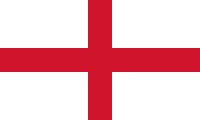 Bobby Houghton (1996)
Bobby Houghton (1996) Roy Wegerle (1996, interim)
Roy Wegerle (1996, interim) Glenn Myernick (1997-00)
Glenn Myernick (1997-00) Tim Hankinson (2001-04)
Tim Hankinson (2001-04) Fernando Clavijo (2005-08)
Fernando Clavijo (2005-08) Gary Smith (2008-)
Gary Smith (2008-)
Gallery of Honor
The Gallery of Honor was established in 2004 to honor former Rapids that had a significant impact on both the team and with the community. The Gallery is commemorated by large banners visible at the north end of Dick's Sporting Goods Park.
 #17 Marcelo Balboa (inducted 2004)
#17 Marcelo Balboa (inducted 2004) #9 Paul Bravo (inducted 2004)
#9 Paul Bravo (inducted 2004) #19 Chris Henderson (inducted 2007)
#19 Chris Henderson (inducted 2007)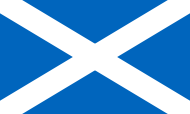 #7 John Spencer (inducted 2009)
#7 John Spencer (inducted 2009)
Team records
- Goals:
 Paul Bravo, 39
Paul Bravo, 39 - Assists:
 Chris Henderson, 53
Chris Henderson, 53 - Games Played:
 Chris Henderson, 178
Chris Henderson, 178 - Minutes Played:
 Chris Henderson, 14,784
Chris Henderson, 14,784 - Shots:
 Chris Henderson, 342
Chris Henderson, 342 - Shots on Goal:
 Chris Henderson, 151
Chris Henderson, 151 - Game-Winning Goals:
 Paul Bravo, 12
Paul Bravo, 12 - Penalty-Kick Goals:
 John Spencer, 9
John Spencer, 9 - Multi-Goal Games:
 Paul Bravo, 7
Paul Bravo, 7 - Hat Tricks:
 Conor Casey, 3
Conor Casey, 3 - Saves:
 Joe Cannon, 349
Joe Cannon, 349 - Shutouts:
 Joe Cannon, 25
Joe Cannon, 25 - Wins:
 Marcus Hahnemann, 39
Marcus Hahnemann, 39
Players in bold are active Rapids players
Last Updated August 12, 2009
Ownership
- Anschutz Entertainment Group (1996–04)
- Kroenke Sports Enterprises (2004-)
Home stadiums
- Mile High Stadium (1996-01)
- Invesco Field at Mile High (2002-06)
- Dick's Sporting Goods Park (2007-)
Year-by-year
| Year | Won | Loss | Tie | Points | Reg. Season | Playoffs | Open Cup | CONCACAF Champions' Cup |
SuperLiga |
|---|---|---|---|---|---|---|---|---|---|
| 1996 | 11 | 21 | NA | 29 | 5th, West | Did not qualify | Semifinals | Not qualifed | Started in 2007 |
| 1997 | 14 | 18 | NA | 38 | 4th, West | Final | Round of 16 | Did not qualify | |
| 1998 | 16 | 16 | NA | 44 | 3rd, West | Quarterfinals | Did not enter | Qualifying Round | |
| 1999 | 20 | 12 | NA | 48 | 4th, West | Quarterfinals | Final | Did not qualify | |
| 2000 | 13 | 15 | 4 | 43 | 3rd, West | Quarterfinals | Round of 32 | Did not qualify | |
| 2001 | 5 | 13 | 18 | 23 | 4th, West | Did not qualify | Round of 32 | Not held | |
| 2002 | 13 | 11 | 4 | 43 | 4th, West | Semifinals | Quarterfinals | Did not qualify | |
| 2003 | 11 | 12 | 7 | 40 | 3rd, West | Quarterfinals | Quarterfinals | Did not qualify | |
| 2004 | 10 | 9 | 11 | 41 | 3rd, West | Quarterfinals | Round of 16 | Did not qualify | |
| 2005 | 13 | 13 | 6 | 45 | 3rd, West | Semifinals | Round of 16 | Did not qualify | |
| 2006 | 11 | 13 | 8 | 41 | 4th, West | Semifinals | Quarterfinals | Did not qualify | |
| 2007 | 9 | 13 | 8 | 35 | 4th, West | Did not qualify | Quarterfinals | Did not qualify | Did not participate |
| 2008 | 11 | 14 | 5 | 38 | 4th, West | Did not qualify | Did not qualify | Did not qualify | Did not qualify |
| 2009 | 10 | 10 | 10 | 40 | 6th, West | Did not qualify | Did not qualify | Did not qualify | Did not qualify |
| Totals | 157 | 180 | 71 |
Note: MLS did not allow ties prior to the 2000 season as games were decided by shootout when tied at full time.
Average attendance
regular season/playoffs
- 1996: 10,213/missed playoffs
- 1997: 11,835/15,785
- 1998: 14,812/6,582
- 1999: 14,029/6,542
- 2000: 12,580/8,789
- 2001: 16,481/missed playoffs
- 2002: 20,687/11,002
- 2003: 16,772/6,434
- 2004: 14,195/8,028
- 2005: 13,638/11,207
- 2006: 12,056/4,176
- 2007: 14,749/missed playoffs
- 2008: 13,659/missed playoffs
- 2009: 13,018/missed playoffs
- All-Time: 14,195/8,731
International competition
- 1998 CONCACAF Champions' Cup
- Qualifying Playoff v.
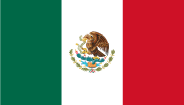 Club León -- 1:0, 2:4 (León advances 4:3 on aggregate)
Club León -- 1:0, 2:4 (León advances 4:3 on aggregate)
- Qualifying Playoff v.
Sources
External links
- Official Club Website
- Dick's Sporting Goods Park, the Rapids' home stadium
- Centennial Firm and Class VI Website
- Bulldog Supporters Group Website
- Rocky Mountain Cup Website
- Official Rapids discussion board, courtesy of BigSoccer
- Colorado Soccer News
|
||||||||||||||||||||||||||||
|
||||||||||||||||||||||||||||||||||||||||||||
|
|||||||||||||||||||||||||||||||
